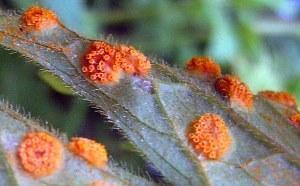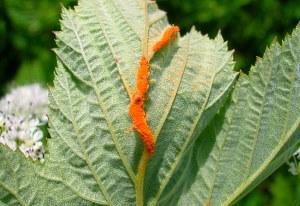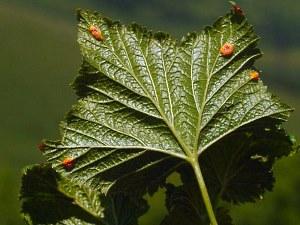Rust appears on currant leaves - what to do?
 Currant is one of the healthiest berries, so every gardener takes care of its bushes to get a good harvest. The appearance of signs of plant disease can upset and scare, but with timely and correct measures, the gardener can easily cope with any problem. The article will focus on the appearance of rust on currant leaves and how to get rid of it.
Currant is one of the healthiest berries, so every gardener takes care of its bushes to get a good harvest. The appearance of signs of plant disease can upset and scare, but with timely and correct measures, the gardener can easily cope with any problem. The article will focus on the appearance of rust on currant leaves and how to get rid of it.
What is it, rust on currant leaves?
Rust on currant leaves is a fungal disease. Most often, spores fall on bushes from conifers, namely from cedar and pine. For this reason, this disease is common in the middle zone of the country.
If spores get on currant leaves, this does not mean that there will be signs of their presence this season. As a rule, the disease develops in a humid atmosphere. But, nevertheless, the fungus hibernates well, so the spread of infection can begin in the spring.

Over time, columns of yellow and red color will grow from the pads, ripe rust spores will hang on them. As the disease spreads by autumn, the entire inner part of the leaf will be covered with rusty hairs, the leaf will literally become fluffy.
How to deal with rust on currants?
There are a number of preventive measures that can be taken to avoid leaf rust problems. First of all, there are special varieties that are particularly resistant to this fungal disease. Residents of the middle zone of the country are better off giving preference to them.
 You should not plant currant bushes near conifers. Otherwise, the risk of spores is very high. Do not forget about spraying currant bushes with agents that increase the plant's endurance.
You should not plant currant bushes near conifers. Otherwise, the risk of spores is very high. Do not forget about spraying currant bushes with agents that increase the plant's endurance.
It is recommended to spray currant bushes in the most important periods for culture:
- the appearance of the first leaves;
- bud formation;
- flowering period;
- ten days after the third spraying with a high risk of spreading the disease.
 For spraying, Bordeaux liquid or copper oxychloride is used. The first is a solution of copper sulfate (50 grams) and quicklime (75 grams) in 5 liters of water. To prepare the second, you need to dilute 35 grams of a 95% drug in 10 liters of water.
For spraying, Bordeaux liquid or copper oxychloride is used. The first is a solution of copper sulfate (50 grams) and quicklime (75 grams) in 5 liters of water. To prepare the second, you need to dilute 35 grams of a 95% drug in 10 liters of water.
If, nevertheless, rust spores appear on the bushes, urgent action is necessary. The following describes how to deal with rust on currants:
- Remove infected leaves from bushes to prevent spores from spreading further.
- It is best to burn the infected leaves, as even in compost the fungus can overwinter and spread to other plants in the spring.
- Spray the bushes with one of the above products.
Even after completing the measures, the gardener must be extremely careful, as spores could remain on the bush. If signs of infection reappear, the above operations should be performed again. Do not forget about preventive additives that increase the degree of plant resistance to various pests, including rust.
If gooseberry bushes grow nearby, then you should pay attention to them, since spores can take root there.
Rust has appeared on the leaves of the currant - what to do in such a situation is now clear. The main thing is not to start caring for the plant, then it will bear fruit with large berries for many years. The fungus, of course, is capable of killing currants, but in caring hands, and it is not a problem. Over time, disputes can be eliminated permanently.
Good article, helpful tips, especially for those who want to grow a rich crop of currants. Every novice gardener should know how to deal with plant diseases. Rust is, indeed, a serious disease, and if nothing is done, then it can completely destroy the bush. It is correctly described in the article that preventive measures (care, feeding) are very important. And if the rust has already appeared, then I also use Bordeaux liquid. She helps a lot. I have tried other drugs, but they are less effective.
Rust on black currant and ruined my life for several years. Then somewhere I read about the treatment with soda ash before flowering and iron vitriol. It seems to have helped. But there was one more thing, it was this bush that had been inhabited by aphids since spring, whatever I did. And then there was an article that aphids love the delicate leaves of currants, since they are fed too much nitrogenous fertilizers. There was a sin. Since I carried out all the activities at the same time, I do not know, the reduction of nitrogen fertilization, soda or vitriol affected, but aphids and rust disappeared at the same time. Rust, I noticed, is even more dangerous because after the leaves have fallen before their time, they begin to come out again, when the plant needs to prepare for wintering, winter hardiness is disturbed. I removed diseased leaves, maybe that's why I saved the garden, other trees and shrubs did not hurt. Conclusion, a balanced diet can create a healthy area. Otherwise, we will water with poisons, and use them ourselves.
Can Bordeaux liquid be used if green berries are already hanging on the currants?
It is possible, only a very weak solution. 1% Bordeaux liquid (100 g of copper sulfate and 100 g of quicklime per 10 liters of water). For processing to be beneficial, you need to properly prepare the mixture. Moreover, it is important not only not to violate the basic principles, but also to "adjust" the acidity of the mixture to the optimum. Do not use metal containers. In one container, extinguish lime and dissolve it in 5 liters of water, in another - dissolve copper sulfate and slowly pour it into the lime solution. Prepare Bordeaux liquid immediately before use, it cannot be stored. A properly prepared blue liquid, slimy to the touch, has a neutral or slightly alkaline reaction. Incorrectly preparing the mixture, you can burn the plants, or, conversely, not kill the sores. Among other things, such a solution clogs the sprayer.
In rainy weather, the more effective are - captan (at a concentration of 0.3-0.5% - 30-50 g per 10 l of water), phthalan (at a concentration of 0.5% - 50 g per 10 l of water), cineb (at a concentration of 0.4% - 40 g of the drug per 10 liters of water).
I sprinkled Skorom at a concentration of 1 ml per 2 liters of water and cut off the leaves, it seemed to help. Bordeaux liquid is only for prophylaxis, in case of illness there is no sense from it.